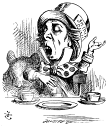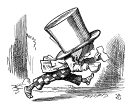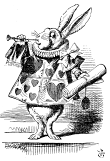Search us!
Search The Word Detective and our family of websites:
This is the easiest way to find a column on a particular word or phrase.
To search for a specific phrase, put it between quotation marks. (note: JavaScript must be turned on in your browser to view results.)
Ask a Question! Puzzled by Posh?
Confounded by Cattycorner?
Baffled by Balderdash?
Flummoxed by Flabbergast?
Perplexed by Pandemonium?
Nonplussed by... Nonplussed?
Annoyed by Alliteration?

Don't be shy!
Send in your question!
Columns from 1995 to 2006 are slowly being added to the above archives. For the moment, they can best be found by using the Search box at the top of this column.
 If you would like to be notified when each monthly update is posted here, sign up for our free email notification list.
If you would like to be notified when each monthly update is posted here, sign up for our free email notification list.
Trivia
All contents herein (except the illustrations, which are in the public domain) are Copyright © 1995-2020 Evan Morris & Kathy Wollard. Reproduction without written permission is prohibited, with the exception that teachers in public schools may duplicate and distribute the material here for classroom use.
Any typos found are yours to keep.
And remember, kids,
Semper Ubi Sub Ubi
|
Perchance to seethe.
Dear Word Detective: Can you please explain the origin of “fever pitch?” Is the musical notion of pitch somehow generalized to mean a rate of speed or intensity? Are you supposed to get a fever when you reach this rate? I’ve looked in your archives and in World Wide Words, and I’ve tried The Google, but I haven’t found any answers. I’m afraid I’m going to break out in a cold sweat. — Don Creach.
That’s a good question. “Fever pitch” is certainly a staple of modern news writing. At the moment, Google News offers 685 links to stories employing the phrase to describe everything from excitement over a new sports league in India (“Investing at fever pitch in India’s cricket bonanza”) to gossip over a celebrity break-up (“The buzz over Reggie Bush and Kim Kardashian’s split has reached fever pitch…”). There are also, predictably, several dozen headlines employing the phrase in connection with the health care reform bill recently passed here in the US (“Health Care Drama Reaches Fever Pitch” being typical), because the key to good journalism is, of course, bad puns.
The American Heritage Dictionary defines “fever pitch” as “a state of extreme agitation or excitement,” but I’d have to add “extremely intense activity” to the list (“Bob was working at a fever pitch in a desperate attempt to meet the midnight tax deadline”). Merriam-Webster Online dates the first use of the phrase to 1846, which seems too recent to me, but I haven’t found anything to contradict that date. Interestingly, the Merriam-Webster Third International Dictionary (1961) offers a weirdly lurid definition of the term: “A degree of abnormal excitement that usually develops rapidly among a number of people and sometimes leads to impulsive violence.” I think I’ve seen that movie. Sidney Poitier makes the crowd see reason in the last reel, right?
The original sense of “pitch” when it first appeared in English as a verb around 1200 was “to thrust in, to fasten firmly” (a sense we still use when we “pitch” a tent), drawn from roots related to “pick” and “prick.” Both the verb and noun forms of “pitch” have acquired a dizzying range of meanings since then, including, for the verb, “to throw,” “to fall suddenly,” and, of course, “to try to sell or convince by persuasion.” As a noun, “pitch” began with the sense of “height, slope or angle of slope,” and then accumulated a range of meanings either associated with “slope” or tied to the verb senses of the word (e.g., a baseball “pitch”). “Pitch” in the sense of “slope” led, in the 16th century, to use of the word to mean “height” in a figurative sense, or the degree of intensity of something. Thus the “pitch” of a sound refers to its “height” or position on a scale, and the “pitch” of an activity or condition refers to its intensity (“The feelings are wound up to a pitch of agony,” William Hazlitt, 1822). This is clearly the sort of “pitch” we have in “fever pitch.”
Prefacing “pitch” with “fever” is a bit ambiguous, but I think the key to unraveling “fever pitch” lies in terms such as “fevered” and “feverish,” both of which denote a state of overwrought excitement, restless energy and delirious frenzy such as might be brought on by a severe fever. Of course, people actually in the grip of a high fever rarely get any constructive work done, and “fever pitch” taken literally would more accurately describe the state of someone wrapped in blankets babbling at the TV than our friend Bob frantically doing his taxes, but that’s the English language for you.
… and welcome to Theological Wheel of Fortune!
Dear Word Detective: A recent piece on the website of the UK’s Telegraph newspaper concluded with this sentence: “If you start dwelling on the fact that you only have to add a ‘d’ to evil to get devil, you soon notice that by taking an ‘o’ away from good, you end up with God.” So what about it — is there any etymological connection between the words “good” and “God”? Or, for that matter, between the words “evil” and “devil”? — Dan Schwartz.
That’s a nifty question, and I especially like your the subject line of your email, “Good God and that evil Devil.” As for the sentence you quote, it reminds me of the sort of thing one sees on the illuminated signs out in front of the churches around here, though I doubt that they’d go for one that long (or that theologically inconclusive). They tend to prefer the short and cutesy, such as “Hell is Un-Cool” or “God Answers Knee-Mail.”
Humans are, of course, pattern-seeking creatures, so an orthographic resemblance between two words tends to jump out at us. (“Orthography” is a fancy word for the spelling, etc., of words.) But the fact that I can’t seem to tell Brad Pitt and Matt Damon apart doesn’t make them brothers, and most resemblances of one word to another are meaningless. All of which is a roundabout way of saying that there is no connection between any of the four words in question.
Although the word “God,” capitalized, is the proper name of the deity of Christianity, we’ll tackle “god” in the generic sense. The English word “god,” which first appeared in Old English, is probably based on the Indo-European root “ghut,” which meant “called or invoked,” giving “god” the sense of “that which is invoked or summoned.” It’s also possible, however, that the root involved was actually “gheu,” meaning “to pour, to offer a sacrifice,” giving us the sense of “one to whom sacrifices or libations are offered.”
Ironically, given your question, the form our modern English adjective and noun “good” took in Old English was the spelling “god” (although it was pronounced with a long “o”). But there is, again, no connection there and the root of “good”is the ancient Germanic “gath,” meaning “to bring together” (and also the root of “gather” and “together”). This root progressed through the senses of “united” to “fitting, suitable,” to “pleasing, satisfactory” to all the various meanings of “good” today.
The interesting thing about “evil” is that it wasn’t so bad when it was young. In fact, the root of “evil,” the Indo-European “upelo,” meant merely “exceeding proper bounds” or “uppity.” Even in Old English, “evil” was used as a fairly bland, general-purpose negative word, encompassing very nasty things or behavior but also applied where today we would probably just use “bad,” “defective” or “unpleasant.” The use of “evil” to mean exclusively “extreme moral depravity or wickedness” only arose in the 19th century.
“Devil” arrived in Old English as “deofol,” meaning “spirit of evil,” drawn from the Greek word “diabolos,” which also gave us “diabolical.” The Greek “diabolos” literally meant “slanderer” or “liar,” being a combination of “dia” (across) and “ballein” (to throw, which also gave us “ballistic”), with the sense of “throwing lies” or attacking by other means. When capitalized, “Devil” is today used to mean Satan, of course, but “devil” is also used in a variety of other senses ranging from “demon” to “charming rogue” (“A man of great talents, who knew a good deal … and was a devil to play,” Thackeray, 1849) to “luckless schmuck” (“Why should he do anything..for a poor devil like me?”, 1876).
Would you say “fairly pretty” is pretty fair?
Dear Word Detective: Can you tell us how the word “pretty” came to mean “rather”? I’ve been making jokes about something being “pretty ugly” for years, but can’t quite picture how something could mean both “nice-looking” and “fairly.” I’ve even thought maybe the word “fair” is a clue, since it can mean nice-looking (at least a few centuries ago it could), and “rather,” as in “fairly soon.” But I still can’t quite make the slide into “pretty” meaning “rather”! Any help you can offer would be appreciated! — Rosemarie Eskes, Rochester, NY
That’s a good question. At least I think it is. I can’t be certain because halfway through reading it I started to feel dizzy (right around your first mention of “fair”), and now my eyes won’t focus. Sometimes I think I’d really be better off writing an advice column for pet owners.
OK, onward. It’s a tribute to the flexibility of the English language that we can use the word “pretty” to mean both “attractive” and “fairly” or “moderately” in the same sentence (“It’s a pretty little house, but its foundation has pretty big problems”) without incurring a major mental meltdown. But given a few centuries of linguistic evolution and our ability to judge the meaning of words by their context, this kind of variation in usage is actually not uncommon.
That’s not to say that “pretty” hasn’t taken some sharp turns in its evolution. It first appeared in Old English as “praettig,” meaning “cunning or crafty,” based on “praett,” meaning “trick.” It soon, in the 1400s, acquired the somewhat less shifty meanings of “clever, skillful and able,” which led to its use meaning “elegantly made or done; ingenious and artful.” Applied to a person, especially a woman or child, “pretty” meant “attractive in appearance,” and in relation to a thing or place, “aesthetically pleasing.” Thus by the 15th century “pretty” as an adjective had settled into its primary modern meaning. But it’s worth noting that even back then there was an implicit distinction in usage between “pretty” and “beautiful,” and “pretty” was often used in a patronizing or even depreciative sense, especially in the form “pretty little,” still very much in use today (“We don’t need to bother our pretty little heads about it,” 1996). (As one dictionary commented in 1909, “Pretty is somewhat of a condescending term; we grant it: beauty is imperious, and commands our acknowledgment.”) By the 16th century, “pretty” was commonly used in an ironic sense to mean “difficult, unwelcome, awkward” (“We drank hard, and returned to our employers in a pretty pickle,” 1809).
The use of “pretty” as an adverb meaning “fairly” or “moderately” also arose in the 16th century. This “so-so” sense was probably an outgrowth of that patronizing use of “pretty” to mean “somewhat attractive” in contrast to “beautiful.” Something that is “pretty good” is thus sufficient, but never “awesomely” or “stunningly” good.
Your hunch that the history of “fair” might be a similar case is right on the money. First appearing in Old English with the meaning “beautiful,” “fair” went on to mean, among other things, “free from bias” (as in “fair trial”) and “free of defect” (“fair complexion”). Eventually “fair” acquired the modern lukewarm senses of “moderate” (“a fair chance of success”) and “tolerable” and, as an adverb, “somewhat,” “passably” and “moderately.”
|
Makes a great gift! Click cover for more.  
400+ pages of science questions answered and explained for kids -- and adults!
FROM ALTOIDS TO ZIMA, by Evan Morris
 
|


 can be found
can be found 




Recent Comments